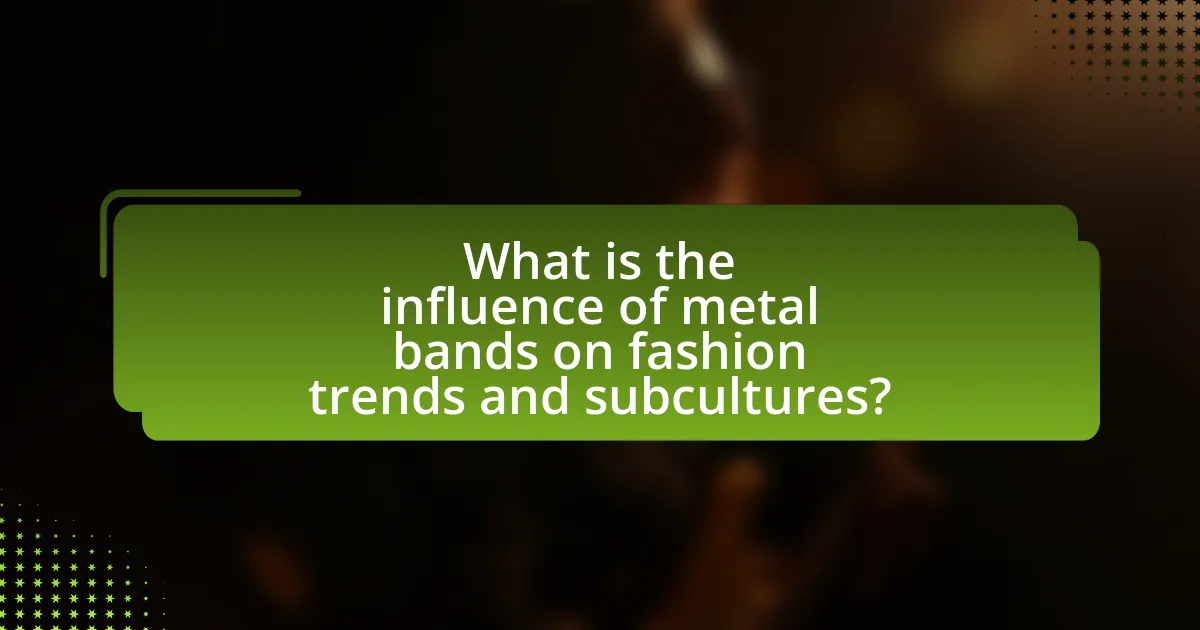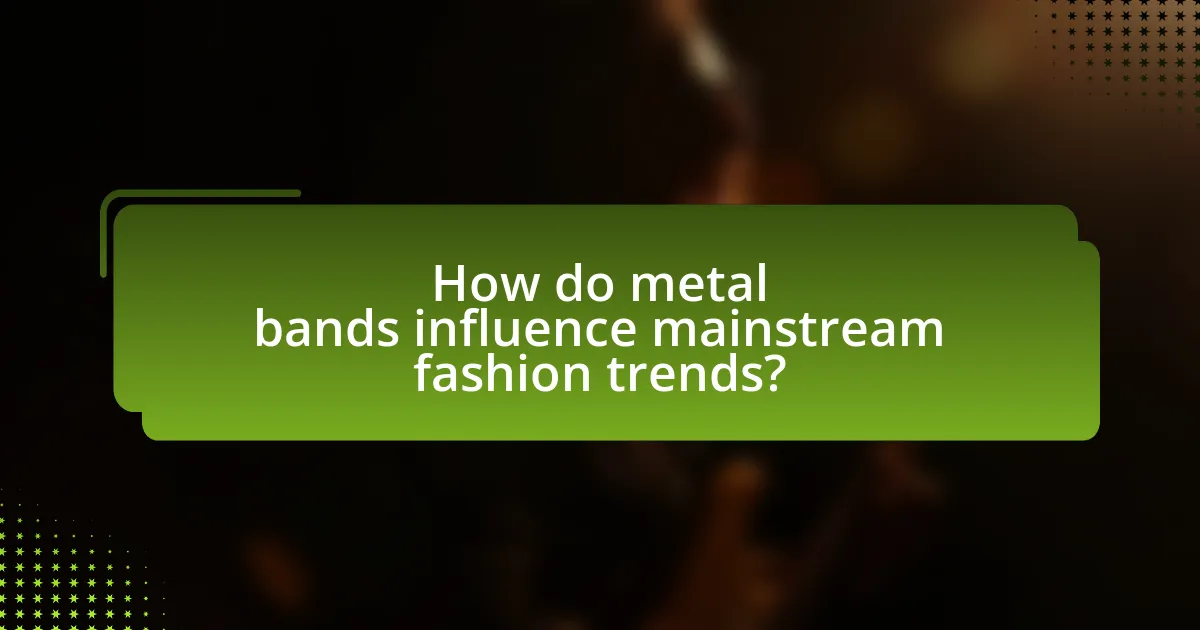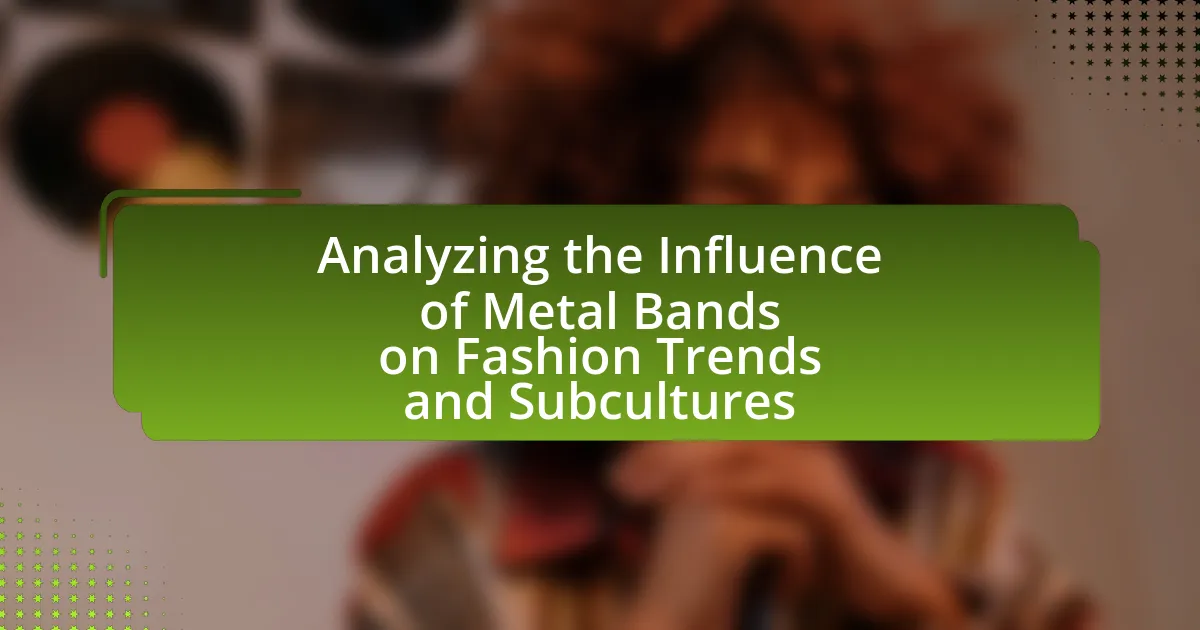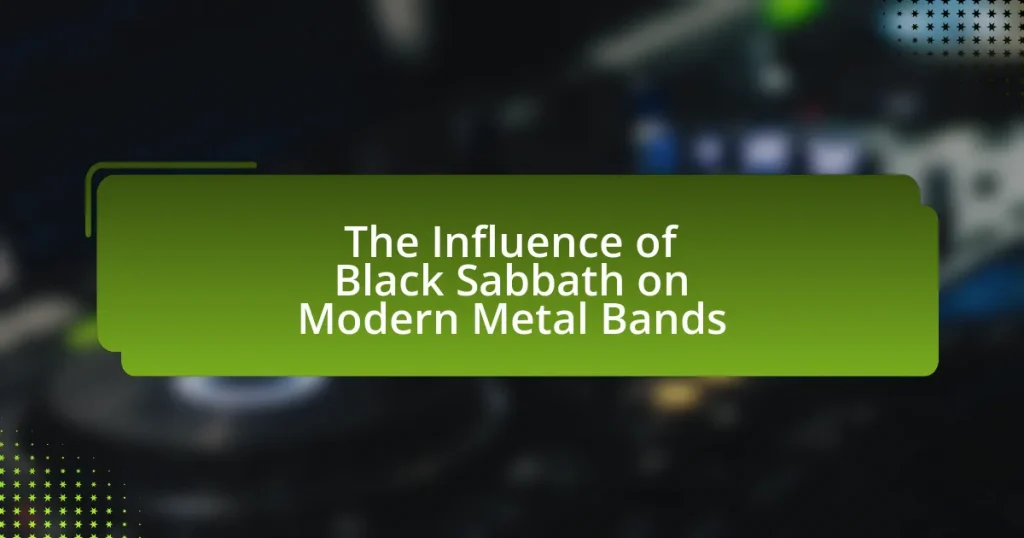The article analyzes the influence of metal bands on fashion trends and subcultures, highlighting how distinctive styles such as leather jackets, band t-shirts, and heavy accessories have become synonymous with metal culture. It explores the evolution of fashion associated with metal music over the decades, detailing how various subgenres like heavy metal, thrash metal, and black metal have shaped unique aesthetics. The article also discusses the significance of these fashion elements in expressing identity and community among fans, as well as the impact of metal bands on mainstream fashion trends through collaborations and media representation. Additionally, it addresses the challenges metal fashion faces in gaining wider acceptance and offers practical tips for fans to incorporate metal-inspired styles into their wardrobes.

What is the influence of metal bands on fashion trends and subcultures?
Metal bands significantly influence fashion trends and subcultures by popularizing distinctive styles characterized by leather jackets, band t-shirts, and heavy metal accessories. This influence is evident in the emergence of subcultures such as heavy metal, thrash metal, and black metal, where fans adopt these fashion elements as a form of identity and expression. For instance, the 1980s saw bands like Metallica and Iron Maiden shape the aesthetic of metal culture, leading to widespread adoption of their imagery and styles among fans. Additionally, the incorporation of elements like spikes, chains, and dark colors in clothing reflects the rebellious spirit associated with metal music, further solidifying its impact on broader fashion trends.
How have metal bands shaped fashion over the decades?
Metal bands have significantly shaped fashion over the decades by introducing distinctive styles that reflect their music and culture. In the 1980s, bands like Metallica and Iron Maiden popularized leather jackets, band t-shirts, and denim, creating a uniform associated with heavy metal culture. The 1990s saw the rise of grunge influences, with bands like Nirvana blending metal aesthetics with thrift store fashion, leading to a more casual look that included flannel shirts and combat boots.
In the 2000s, metalcore bands such as Killswitch Engage and Avenged Sevenfold incorporated elements of streetwear, including hoodies and sneakers, while maintaining traditional metal motifs like spikes and chains. This evolution illustrates how metal bands have not only influenced their fans’ clothing choices but also impacted broader fashion trends, as designers have drawn inspiration from the rebellious spirit and visual identity of metal culture.
The ongoing influence of metal bands on fashion is evident in collaborations between musicians and fashion brands, showcasing the genre’s lasting impact on style and subculture.
What specific fashion elements are associated with metal bands?
Metal bands are associated with specific fashion elements such as leather jackets, band t-shirts, denim, spikes, and heavy boots. These elements reflect the rebellious and edgy aesthetic of the metal genre. Leather jackets, often adorned with patches and studs, symbolize a sense of toughness and individuality, while band t-shirts promote the artists and their music. Denim, particularly in the form of ripped jeans, adds to the casual yet defiant look. Spikes and chains are frequently used as accessories, enhancing the aggressive style. Heavy boots, such as combat or platform styles, complete the ensemble, providing both durability and a bold statement. These fashion choices have roots in the punk and rock movements of the 1970s and 1980s, influencing the overall identity of metal culture.
How do these fashion elements reflect the identity of metal subcultures?
Fashion elements in metal subcultures, such as leather jackets, band t-shirts, and heavy boots, reflect a rebellious identity and a sense of belonging among fans. These elements symbolize defiance against mainstream culture and express individuality, often incorporating dark aesthetics that resonate with the themes of metal music. For instance, the use of spikes and chains in attire signifies strength and aggression, aligning with the aggressive sound of metal genres. Additionally, band merchandise serves as a badge of loyalty and community, reinforcing connections among fans. This fashion not only showcases personal style but also acts as a visual representation of the values and attitudes inherent in metal subcultures, such as authenticity and resistance to conformity.
Why is the relationship between metal music and fashion significant?
The relationship between metal music and fashion is significant because it serves as a form of identity expression for fans and artists alike. Metal music often incorporates themes of rebellion, individuality, and non-conformity, which are visually represented through distinctive fashion choices such as leather jackets, band t-shirts, and unique hairstyles. This fashion not only reflects the music’s ethos but also creates a sense of community among fans, reinforcing group identity. Historical examples include the rise of heavy metal in the 1970s and 1980s, where bands like Black Sabbath and Iron Maiden influenced fashion trends that became synonymous with the genre, leading to the establishment of subcultures that embraced these styles.
What role does fashion play in the expression of metal music culture?
Fashion plays a crucial role in the expression of metal music culture by serving as a visual representation of identity and community. The distinctive styles, such as leather jackets, band t-shirts, and heavy metal accessories, create a sense of belonging among fans and musicians alike. This fashion not only reflects the aggressive and rebellious themes of metal music but also acts as a form of self-expression, allowing individuals to showcase their allegiance to specific bands or subgenres. Historical evidence shows that iconic bands like Black Sabbath and Metallica have significantly influenced fashion trends within the metal community, leading to the widespread adoption of their styles by fans. This interplay between fashion and music solidifies the cultural identity of metal, making it a vital aspect of its overall expression.
How does fashion contribute to the community and identity of metal fans?
Fashion significantly contributes to the community and identity of metal fans by serving as a visual representation of their shared values and beliefs. The distinctive styles, such as band t-shirts, leather jackets, and accessories like spikes and chains, create a sense of belonging among fans, reinforcing their connection to the metal genre and its culture. This fashion not only differentiates metal fans from other music communities but also symbolizes rebellion, individuality, and a collective identity rooted in the music’s themes of empowerment and defiance. Historical context shows that the fashion choices of iconic metal bands, such as Metallica and Iron Maiden, have influenced fans’ attire, further solidifying the relationship between fashion and the metal community.
What are the key subcultures influenced by metal bands?
The key subcultures influenced by metal bands include heavy metal, thrash metal, black metal, and death metal subcultures. Each of these subcultures has distinct characteristics, such as fashion styles, attitudes, and musical preferences that reflect the themes and aesthetics of the respective metal genres. For instance, heavy metal subculture is known for its leather jackets, band t-shirts, and long hair, while black metal subculture often features corpse paint and dark, gothic attire. The influence of these subcultures is evident in their dedicated fan bases, which often participate in community events, festivals, and underground scenes that celebrate the music and its associated lifestyle.
How do different metal genres impact their respective fashion styles?
Different metal genres significantly influence their respective fashion styles by establishing distinct aesthetics that reflect the music’s themes and cultural contexts. For instance, heavy metal often features leather jackets, band t-shirts, and denim, symbolizing rebellion and toughness, while subgenres like black metal emphasize dark, gothic attire, including corpse paint and spikes, to convey a sense of mystique and anti-establishment sentiment. Additionally, genres such as glam metal showcase flamboyant clothing, bright colors, and makeup, reflecting a more theatrical and extravagant approach. These fashion choices are not merely superficial; they serve as visual representations of the genre’s identity and values, reinforcing community bonds among fans. Historical context supports this, as the rise of punk and metal in the 1970s and 1980s led to the emergence of specific fashion trends that continue to evolve today, demonstrating the ongoing relationship between music and style within the metal subculture.
What are the historical origins of these metal subcultures?
The historical origins of metal subcultures can be traced back to the late 1960s and early 1970s, primarily emerging from the hard rock and psychedelic rock scenes. Bands like Black Sabbath and Led Zeppelin played pivotal roles in shaping the sound and aesthetic that would define heavy metal, characterized by distorted guitars, powerful vocals, and dark themes. The subculture gained momentum in the 1980s with the rise of genres such as thrash metal and glam metal, leading to distinct fashion styles, including leather jackets, band t-shirts, and long hair, which became emblematic of the metal identity. The establishment of festivals and dedicated fan communities further solidified these subcultures, creating a lasting impact on music and fashion.

How do metal bands influence mainstream fashion trends?
Metal bands influence mainstream fashion trends by popularizing specific styles and aesthetics associated with their music and culture. For instance, the rise of heavy metal in the 1980s introduced leather jackets, band t-shirts, and denim as staples in youth fashion, which were later adopted by mainstream brands. Iconic bands like Metallica and Iron Maiden have had their merchandise become fashion statements, leading to collaborations with high-fashion designers and brands. This crossover is evident in runway shows where elements of metal fashion, such as spikes, studs, and dark color palettes, are showcased, reflecting the genre’s impact on broader fashion trends.
What are the mechanisms through which metal fashion enters mainstream culture?
Metal fashion enters mainstream culture primarily through the influence of music videos, celebrity endorsements, and social media platforms. Music videos featuring metal bands often showcase distinctive fashion styles, which fans emulate, thereby creating a ripple effect into broader fashion trends. Celebrity endorsements, where popular figures adopt metal fashion, further legitimize and popularize these styles among wider audiences. Additionally, social media platforms facilitate the rapid dissemination of metal fashion trends, allowing for real-time sharing and adaptation by influencers and fashion enthusiasts. This interconnectedness of music, celebrity culture, and digital communication channels effectively integrates metal fashion into mainstream culture.
How do collaborations between metal bands and fashion designers occur?
Collaborations between metal bands and fashion designers occur through mutual interest in aesthetics and brand alignment. Metal bands often seek to enhance their image and connect with fans through unique merchandise, while fashion designers look to tap into the subculture’s rebellious spirit and dedicated audience. These collaborations typically arise from direct outreach, networking at industry events, or through established relationships within the music and fashion industries. For instance, the partnership between the band Metallica and the fashion brand All Within My Hands Foundation exemplifies how bands leverage fashion to create exclusive apparel that resonates with their fan base, thereby reinforcing their brand identity.
What impact do music videos and performances have on fashion trends?
Music videos and performances significantly influence fashion trends by showcasing distinctive styles that fans and the general public often emulate. For instance, iconic music videos, such as Madonna’s “Vogue” and Michael Jackson’s “Thriller,” introduced specific clothing styles that became mainstream, leading to increased sales in similar apparel. Research indicates that visual media, particularly music videos, serve as powerful platforms for setting fashion trends, as they reach millions of viewers and create aspirational imagery. The impact is further evidenced by the rise of streetwear, which gained popularity through artists like Kanye West and Travis Scott, whose performances and videos highlight unique fashion choices that resonate with their audiences.
Why do fashion brands seek inspiration from metal bands?
Fashion brands seek inspiration from metal bands primarily due to the subculture’s strong visual identity and rebellious ethos. Metal bands often embody a distinctive aesthetic characterized by dark colors, bold graphics, and edgy styles, which resonate with themes of individuality and defiance. This aesthetic appeals to fashion brands aiming to attract consumers who value authenticity and countercultural elements. For instance, the rise of streetwear has seen collaborations with metal bands, leveraging their iconic imagery to create unique fashion statements that reflect a blend of music and style. The influence of metal on fashion is evident in collections that incorporate elements like leather jackets, band tees, and graphic prints, which have become staples in contemporary fashion.
What are the benefits for brands in associating with metal culture?
Brands benefit from associating with metal culture by gaining access to a passionate and loyal consumer base. This demographic often exhibits strong brand loyalty, as evidenced by studies showing that 70% of metal fans are likely to support brands that align with their values and interests. Additionally, metal culture is characterized by a distinct aesthetic that can enhance a brand’s image, allowing for unique marketing opportunities that resonate with consumers. Collaborations with metal bands can also lead to increased visibility and engagement on social media platforms, where metal communities are highly active. Overall, aligning with metal culture can drive brand recognition and foster deeper connections with a dedicated audience.
How does this association affect consumer perceptions of both the brand and the music?
The association between metal bands and fashion trends significantly enhances consumer perceptions of both the brand and the music. This connection often leads consumers to view the brand as more authentic and aligned with their identity, particularly within subcultures that value rebellion and individuality. For instance, brands that collaborate with metal bands can leverage the band’s established fan base, resulting in increased brand loyalty and a perception of exclusivity. Research indicates that consumers are more likely to purchase products endorsed by artists they admire, as seen in a study by the Journal of Marketing Research, which found that celebrity endorsements can increase consumer trust and purchase intentions by up to 20%. Thus, the synergy between metal music and fashion not only elevates the brand’s image but also deepens the emotional connection fans have with the music.
What are some notable examples of metal fashion in mainstream media?
Notable examples of metal fashion in mainstream media include the iconic leather jackets and band t-shirts worn by artists like Ozzy Osbourne and Metallica, which have influenced streetwear and high fashion alike. The 1980s glam metal scene, featuring bands like Mötley Crüe and Poison, popularized spandex, big hair, and heavy makeup, which were widely depicted in music videos and magazines. Additionally, the documentary “Metal: A Headbanger’s Journey” highlights the cultural significance of metal fashion, showcasing how it reflects identity and rebellion within the genre. These elements have permeated various media, reinforcing the lasting impact of metal fashion on broader cultural trends.
How have iconic metal fashion moments influenced popular culture?
Iconic metal fashion moments have significantly influenced popular culture by shaping trends in music, art, and youth identity. The bold aesthetics of metal bands, characterized by leather jackets, spikes, and elaborate hairstyles, have permeated mainstream fashion, inspiring designers and artists across various genres. For instance, the 1980s glam metal scene, led by bands like Mötley Crüe and Poison, introduced flamboyant styles that were later adopted by pop artists, demonstrating a crossover effect. Additionally, the visual elements of metal, such as album artwork and music videos, have influenced graphic design and streetwear, creating a lasting impact on cultural expressions. The embrace of metal fashion by celebrities and influencers further solidifies its role in shaping contemporary style, showcasing its enduring relevance in popular culture.
What role do celebrities play in promoting metal-inspired fashion trends?
Celebrities play a significant role in promoting metal-inspired fashion trends by leveraging their visibility and influence to shape public perceptions and consumer behavior. For instance, musicians like Ozzy Osbourne and members of bands such as Metallica have not only popularized specific styles, such as leather jackets and band tees, but have also created a cultural association between these fashion choices and the metal genre. This influence is evident in fashion shows and collaborations, where designers often draw inspiration from the aesthetics of metal culture, further solidifying its presence in mainstream fashion. Additionally, social media platforms amplify this effect, as celebrities showcase their metal-inspired outfits, leading to increased demand and adoption among fans and fashion enthusiasts.
What are the future trends of metal bands’ influence on fashion?
The future trends of metal bands’ influence on fashion will likely emphasize a blend of vintage aesthetics and modern streetwear elements. As metal bands continue to evolve, their iconic imagery, such as band logos and album artwork, will increasingly be integrated into mainstream fashion, appealing to a broader audience. This trend is supported by the resurgence of 90s and early 2000s styles, which have seen a revival in recent years, as evidenced by collaborations between metal bands and high-profile fashion brands. Additionally, the rise of sustainable fashion practices may lead metal bands to adopt eco-friendly materials and production methods, further shaping their influence on contemporary fashion.
How is the evolution of metal music affecting fashion trends today?
The evolution of metal music is significantly influencing contemporary fashion trends by promoting a blend of edgy aesthetics and individualistic styles. As metal music has diversified into various subgenres, such as black metal and metalcore, it has introduced distinct visual elements, including dark clothing, band merchandise, and accessories like spikes and leather, which are now prevalent in mainstream fashion. For instance, the rise of streetwear brands incorporating metal-inspired graphics and motifs reflects this influence, as seen in collaborations between fashion designers and metal bands. Additionally, the resurgence of vintage band tees and distressed denim in everyday wear highlights how metal culture continues to shape fashion choices, appealing to both fans and fashion enthusiasts alike.
What emerging styles are being adopted by new metal bands?
New metal bands are increasingly adopting styles that blend elements of electronic music, hip-hop, and alternative rock, creating a fusion genre often referred to as “nu-metal” or “trap metal.” This evolution is characterized by the incorporation of heavy guitar riffs, aggressive vocals, and electronic beats, reflecting a shift towards a more diverse sound palette. For instance, bands like Ghostemane and Scarlxrd exemplify this trend by merging metal with trap influences, showcasing a growing acceptance of genre-blending in contemporary music. This stylistic shift not only influences the sound but also impacts fashion trends within the subculture, as artists often adopt streetwear aesthetics that resonate with their musical identity.
How are social media and digital platforms changing the fashion landscape for metal culture?
Social media and digital platforms are transforming the fashion landscape for metal culture by enabling rapid dissemination of trends and fostering community engagement. These platforms allow metal bands and fans to share their unique styles, leading to a more diverse representation of fashion within the subculture. For instance, Instagram and TikTok have become vital for showcasing outfits, accessories, and DIY fashion inspired by metal music, which encourages creativity and individual expression. Additionally, the accessibility of online marketplaces facilitates the purchase of niche fashion items, such as band merchandise and custom designs, directly from independent creators. This shift has resulted in a more interconnected global community, where influences can cross borders quickly, reshaping traditional fashion norms within metal culture.
What challenges do metal bands face in influencing fashion trends?
Metal bands face significant challenges in influencing fashion trends due to their niche audience and the often misunderstood nature of their genre. The heavy metal community is characterized by a strong sense of identity and loyalty, which can limit broader appeal and acceptance of their fashion styles in mainstream culture. Additionally, the aggressive and rebellious aesthetics associated with metal may not resonate with the general public, making it difficult for these bands to set trends that gain traction outside their fan base. Historical context shows that while bands like Metallica and Iron Maiden have made some impact on fashion, their influence is often overshadowed by more commercially viable genres, such as pop and hip-hop, which dominate the fashion landscape.
How do societal perceptions of metal music impact its fashion influence?
Societal perceptions of metal music significantly impact its fashion influence by shaping the acceptance and adoption of metal-inspired styles in mainstream culture. The often misunderstood and stigmatized nature of metal music has led to a distinct fashion aesthetic characterized by leather, band t-shirts, and heavy accessories, which can be seen as a form of rebellion against societal norms. This fashion influence is reinforced by the visibility of metal bands in media and their association with countercultural movements, which often challenge conventional fashion standards. For instance, studies have shown that as metal music gains popularity and acceptance, elements of its fashion are increasingly integrated into broader fashion trends, reflecting a shift in societal attitudes towards the genre.
What barriers exist for metal fashion in gaining wider acceptance?
Metal fashion faces several barriers to gaining wider acceptance, primarily due to societal perceptions and stereotypes associated with the metal subculture. These perceptions often label metal fashion as aggressive or non-conformist, which can alienate mainstream audiences. Additionally, the niche market for metal fashion limits its visibility and accessibility, making it less likely to be adopted by the general public. Cultural stigmas surrounding metal music and its associated styles further reinforce these barriers, as many individuals may view metal fashion as inappropriate or extreme. Studies indicate that fashion trends often require a degree of social validation to gain traction, and the negative associations with metal culture hinder this process.
What practical tips can fans adopt to incorporate metal fashion into their wardrobe?
Fans can incorporate metal fashion into their wardrobe by selecting key elements such as band t-shirts, leather jackets, and combat boots. Band t-shirts serve as a staple, showcasing favorite artists while providing a casual look. Leather jackets add an edgy aesthetic and durability, often associated with the rebellious spirit of metal culture. Combat boots, known for their ruggedness, complement the overall style and offer comfort. Additionally, accessories like studded belts and bracelets can enhance the metal vibe, reflecting the genre’s aesthetic. This approach aligns with the historical significance of metal fashion, which has roots in the 1970s and 1980s, where bands like Black Sabbath and Iron Maiden influenced not only music but also clothing styles.
How can fans express their identity through metal-inspired fashion choices?
Fans can express their identity through metal-inspired fashion choices by adopting styles that reflect their musical preferences and personal beliefs. This expression often includes wearing band merchandise, such as T-shirts featuring logos or album art, which signifies allegiance to specific bands and genres. Additionally, fans may incorporate elements like leather jackets, studded accessories, and dark colors, which are emblematic of the metal subculture and convey a sense of rebellion and individuality. Research indicates that fashion choices in subcultures, including metal, serve as a form of social identity, allowing individuals to connect with like-minded communities and assert their uniqueness within broader societal norms.
What are some common mistakes to avoid when adopting metal fashion styles?
Common mistakes to avoid when adopting metal fashion styles include over-accessorizing, failing to understand the subculture’s history, and neglecting personal comfort. Over-accessorizing can lead to a cluttered appearance that detracts from the intended aesthetic, as metal fashion often emphasizes bold, statement pieces rather than excessive adornment. Understanding the history of metal fashion is crucial; many styles are rooted in specific bands or movements, and misrepresenting these can lead to cultural appropriation or inauthenticity. Additionally, neglecting personal comfort can result in a lack of confidence, as metal fashion often incorporates heavy materials and tight fits that may not be suitable for everyone. These mistakes can undermine the authenticity and impact of one’s metal fashion expression.


